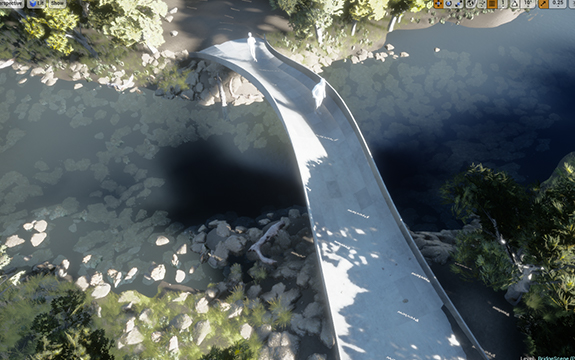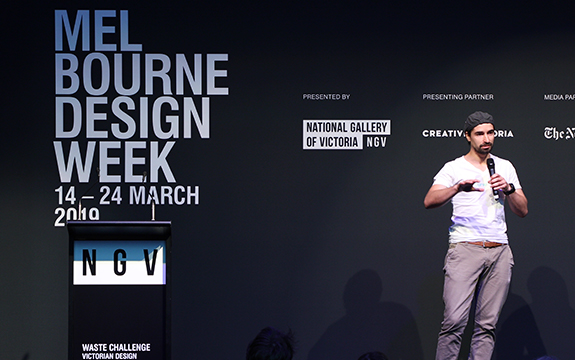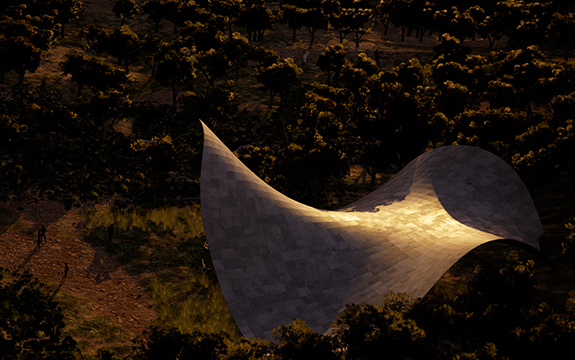
Render of curved bridge structure using Curvecrete. Image supplied by Curvecrete
In summary
- Curvecrete a finalist in the NGV Design Challenge at Melbourne Design Week
- Technology behind Curvecrete conceived at University of Melbourne's TRaM Program
- Curvecrete co-founder Daniel Prohasky is Veski Innovator of the Year 2019
Daniel Prohasky is an Innovation Fellow at Swinburne's Faculty of Health, Arts and Design, an architectural engineer and roboticist. With entrepreneur Warren Rudd, Mr Prohasky is co-founder of Curvecrete, a spin-out on a mission to commercialise sustainable and waste free concrete production and complex concrete curve forming technologies.
Curvecrete was conceived when Mr Prohasky, Mr Rudd and University of Melbourne researcher Paul Loh participated in the University of Melbourne's Translating Research at Melbourne program. It was recently a finalist in the NGV Design Challenge during Melbourne Design Week.
 Daniel Prohasky presenting Curvecrete at the NGV Design Challenge.
Daniel Prohasky presenting Curvecrete at the NGV Design Challenge.
Mr Prohasky and his team are working on tandem innovations to produce zero waste sustainable concrete forms for construction. The first is the utilisation of sustainable no-waste concrete, a geopolymer cement made from fly-ash, produced by coal-fired power stations.
"Australia currently wastes 6.8 million tonnes of fly ash each year, yet it's a viable cement replacement. Curvecrete geopolymer cement produces eighty per cent less emissions than standard Portland cement, with no need to use calcine limestone, removing 55 per cent of emissions created in cement production," explains Mr Prohasky.
The second is to create sustainable curved concrete forms and constructions that reduce the need for wasteful formwork. Prohasky and his team are using a robotic mechanical mould technology to create curved concrete panels for construction in geopolymer cement.
"Curved concrete can create incredibly efficient mass-reduced structures, and our reusable mechanical formwork eliminates all the formwork waste typically associated with traditional methods of casting concrete," says Mr Prohasky.
"Architects and master builders have aspired to create beautifully curved architectural forms for centuries. Gaudi's work is of particular importance. He simplified curved forms into hyperbolic ruled surfaces to create logical junctions and coordinate building modules. The ruled surface geometries created by Curvecrete mimic that of Gaudi's," he says.
 Render of Curvecrete pavillion structure. Image supplied by Curvecrete.
Render of Curvecrete pavillion structure. Image supplied by Curvecrete.
The patented Parametric Adjustable Mould (PAM) technology that Curvecrete uses was co-invented by researchers Paul Loh and David Leggett with Mr Prohasky at the Melbourne School of Design at the University of Melbourne. PAM is a reusable robotic deformable mould that creates doubly-curved concrete forms without creating any formwork waste.
As an Innovation Fellow, Mr Prohasky is working in Swinburne's Innovation Precinct with support from Swinburne's Smart Cities Research Institute and the Digital Construction Laboratory team. He also lectures in Architectural Engineering.
"Curvecrete technology is capable of creating beautifully formed architectural structures. However, it's incredibly difficult to enter the building and construction commercial market, and investment can be difficult to come by in this environment if the technology is not acceptably de-risked," Mr Prohasky explains.
"We've developed a strategy to market that is focused on growth, and with the right investment team, Curvecrete sees the technology servicing the Australia-wide market within the next two to three years, with plans to execute globally within five to seven years.
"We want designers to access the technology to test the application of the Curvecrete system on their designs internationally. Our focus is on making a difference and having a positive impact in the building and construction industry, and ultimately on the environment," he says.
Mr Rudd recently presented at Melbourne Knowledge Week to launch Curvecrete's successful entry into the Melbourne Accelerator Program and Mr Prohasky was awarded Veski's innovator of the year, 2019 after wowing the crowd at Federation Square.






